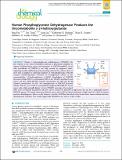| dc.contributor.author | Teng, Xin | |
| dc.contributor.author | Liu, Ling | |
| dc.contributor.author | Looper, Ryan E. | |
| dc.contributor.author | Rabinowitz, Joshua D. | |
| dc.contributor.author | Vander Heiden, Matthew G. | |
| dc.contributor.author | Mattaini, Katherine Ruth | |
| dc.contributor.author | Fan, Jing,M. Eng.Massachusetts Institute of Technology. | |
| dc.date.accessioned | 2016-12-15T14:42:06Z | |
| dc.date.available | 2016-12-15T14:42:06Z | |
| dc.date.issued | 2014-11 | |
| dc.date.submitted | 2014-08 | |
| dc.identifier.issn | 1554-8929 | |
| dc.identifier.issn | 1554-8937 | |
| dc.identifier.uri | http://hdl.handle.net/1721.1/105823 | |
| dc.description.abstract | Human d-3-phosphoglycerate dehydrogenase (PHGDH), the first enzyme in the serine biosynthetic pathway, is genomically amplified in tumors including breast cancer and melanoma. In PHGDH-amplified cancer cells, knockdown of PHGDH is not fully rescued by exogenous serine, suggesting possible additional growth-promoting roles for the enzyme. Here we show that, in addition to catalyzing oxidation of 3-phosphoglycerate, PHGDH catalyzes NADH-dependent reduction of α-ketoglutarate (AKG) to the oncometabolite d-2-hydroxyglutarate (d-2HG). Knockdown of PHGDH decreased cellular 2HG by approximately 50% in the PHGDH-amplified breast cancer cell lines MDA-MB-468 (normal concentration 93 μM) and BT-20 (normal concentration 35 μM) and overexpression of PHGDH increased cellular 2HG by over 2-fold in non-PHGDH-amplified MDA-MB-231 breast cancer cells, which normally display very low PHGDH expression. The reduced 2HG level in PHGDH knockdown cell lines can be rescued by PHGDH re-expression, but not by a catalytically inactive PHGDH mutant. The initial connection between cancer and d-2HG involved production of high levels of d-2HG by mutant isocitrate dehydrogenase. More recently, however, elevated d-2HG has been observed in breast cancer tumors without isocitrate dehydrogenase mutation. Our results suggest that PHGDH is one source of this d-2HG. | en_US |
| dc.description.sponsorship | National Institutes of Health (U.S.) (Grants 1R01CA163591, P50GM07150 and P30CA14051) | en_US |
| dc.description.sponsorship | American Association for Cancer Research | en_US |
| dc.description.sponsorship | National Science Foundation (U.S.) | en_US |
| dc.description.sponsorship | Burroughs Wellcome Fund | en_US |
| dc.language.iso | en_US | |
| dc.publisher | American Chemical Society (ACS) | en_US |
| dc.relation.isversionof | http://dx.doi.org/10.1021/cb500683c | en_US |
| dc.rights | Article is made available in accordance with the publisher's policy and may be subject to US copyright law. Please refer to the publisher's site for terms of use. | en_US |
| dc.source | ACS | en_US |
| dc.title | Human Phosphoglycerate Dehydrogenase Produces the Oncometabolite d-2-Hydroxyglutarate | en_US |
| dc.type | Article | en_US |
| dc.identifier.citation | Fan, Jing et al. “Human Phosphoglycerate Dehydrogenase Produces the Oncometabolite d-2-Hydroxyglutarate.” ACS Chemical Biology 10.2 (2015): 510–516. CrossRef. Web. © 2014 American Chemical Society | en_US |
| dc.contributor.department | Massachusetts Institute of Technology. Department of Biology | en_US |
| dc.contributor.department | Koch Institute for Integrative Cancer Research at MIT | en_US |
| dc.contributor.mitauthor | Vander Heiden, Matthew G. | |
| dc.contributor.mitauthor | Mattaini, Katherine Ruth | |
| dc.relation.journal | ACS Chemical Biology | en_US |
| dc.eprint.version | Final published version | en_US |
| dc.type.uri | http://purl.org/eprint/type/JournalArticle | en_US |
| eprint.status | http://purl.org/eprint/status/PeerReviewed | en_US |
| dspace.orderedauthors | Fan, Jing; Teng, Xin; Liu, Ling; Mattaini, Katherine R.; Looper, Ryan E.; Vander Heiden, Matthew G.; Rabinowitz, Joshua D. | en_US |
| dspace.embargo.terms | N | en_US |
| dc.identifier.orcid | https://orcid.org/0000-0002-6702-4192 | |
| dc.identifier.orcid | https://orcid.org/0000-0003-0046-1360 | |
| mit.license | PUBLISHER_POLICY | en_US |
| mit.metadata.status | Complete | |
